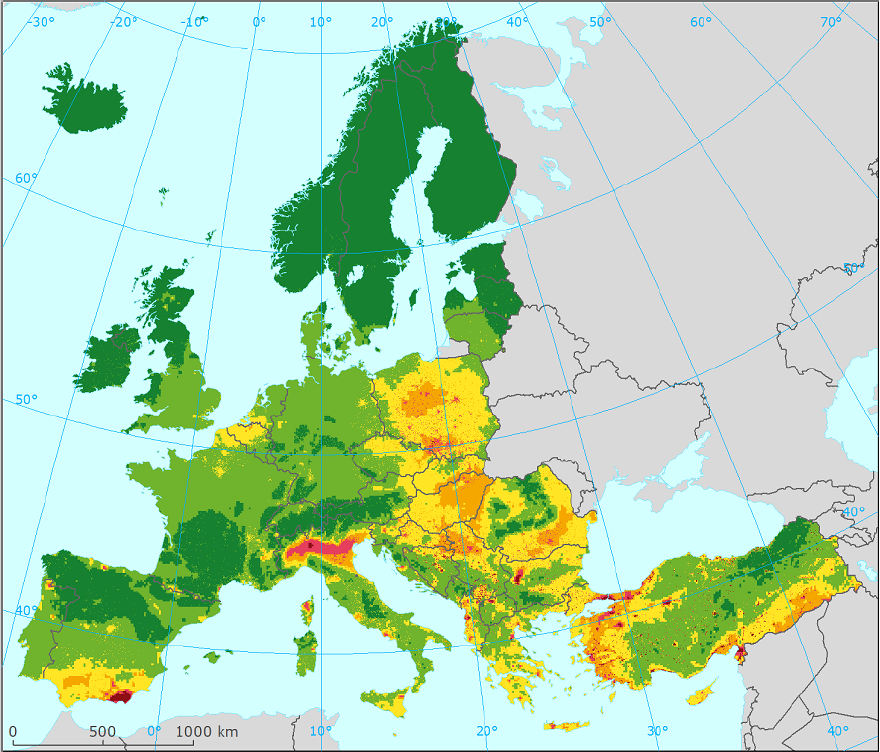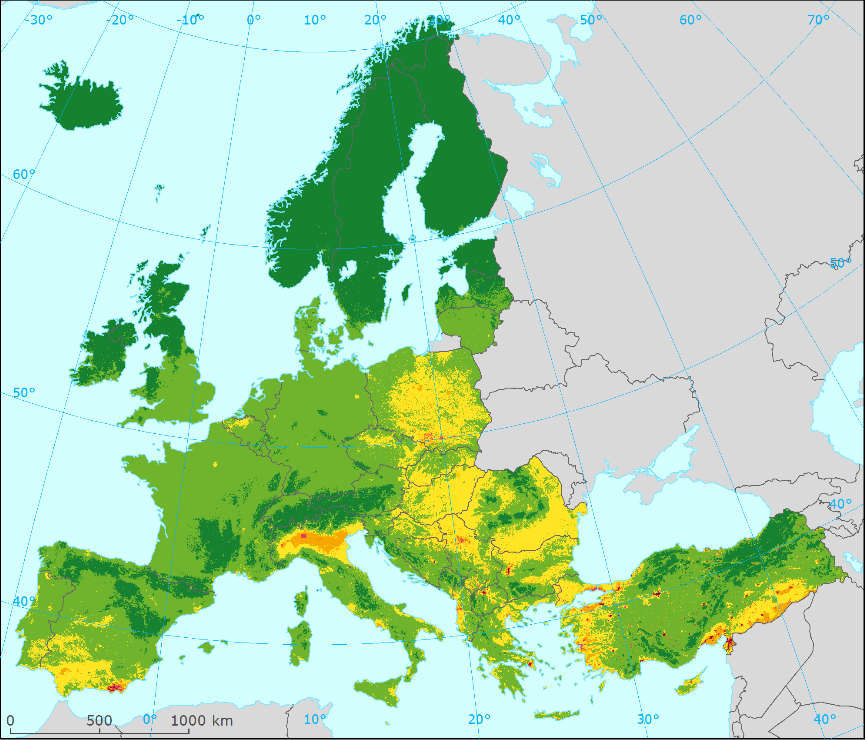Air pollution
Type of resources
Available actions
Topics
INSPIRE themes
Keywords
Contact for the resource
Provided by
Years
Formats
Representation types
Update frequencies
status
Scale
Resolution
-

Member States provide an annual assessment of air quality in comparison to EU air quality thresholds. Commission Decision 2004/461/EC provides a questionnaire to be used by the Member States for the annual reporting under the Framework Directive and the related four Daughter Directives 1999/30/EC, 2000/69/EC, 2002/3/EC and 2004/107/EC. Member States have to divide their entire territory into zones. Zones can be regarded as the primary territorial units for assessment and management of air quality under the air quality directives. Consequently, unambiguous definition of all zones is needed. Member States have employed different approaches for the definition of their zones. Some Member States have divided their territory into a single set of zones serving all pollutants. Other Member States have defined a single base set of zones and modified some of the zones for the application to particular pollutants. Where a Member State has distinguished different sets of zones in relation to health protection and ecosystem/vegetation protection respectively, a single location can be situated in several zones, e.g. in a zone defined for all pollutants except lead and in another, larger zone defined for lead. More information about EU air quality standards is available on the DG Environment web site at http://ec.europa.eu/environment/air/quality/standards.htm. Pursuant to Article 22 of Directive 2008/50/EC, Member States may notify to the Commission when in their opinion the conditions are met in a given zone or agglomeration for postponing the attainment deadline for the limit values for nitrogen dioxide and benzene, or for being exempt from the limit values for PM10. More information is available at: http://ec.europa.eu/environment/air/quality/legislation/time_extensions.htm . Additional information is available in The annual technical overview and analysis of the reports submitted by Member States (http://acm.eionet.europa.eu/databases/aq-questionnaire/annual_reports_aqq.html). Zones are designated for the following pollutants: B – Benzene; BaP – Benzo(a)pyrene; C – Carbon Monoxide; L – lead; AsCdNi – Heavy metals: Arsenic, Cadmium, Nickel; NH – Nitrogen Dioxide for human protection; NV – NOx for vegetation protection; O – ozone; PM10 – particulate matter less than 10 microgrammes; PM25 – particulate matter less than 2.5 microgrammes; SE – SO2 for ecosystems protection; SH – SO2 for human protection. ************ In this revision 2, Montenegro was added to the SE and NV datasets. ************
-

Member States provide an annual assessment of air quality in comparison to EU air quality thresholds. Commission Decision 2004/461/EC provides a questionnaire to be used by the Member States for the annual reporting under the Framework Directive and the related four Daughter Directives 1999/30/EC, 2000/69/EC, 2002/3/EC and 2004/107/EC. Member States have to divide their entire territory into zones. Zones can be regarded as the primary territorial units for assessment and management of air quality under the air quality directives. Consequently, unambiguous definition of all zones is needed. Member States have employed different approaches for the definition of their zones. Some Member States have divided their territory into a single set of zones serving all pollutants. Other Member States have defined a single base set of zones and modified some of the zones for the application to particular pollutants. Where a Member State has distinguished different sets of zones in relation to health protection and ecosystem/vegetation protection respectively, a single location can be situated in several zones, e.g. in a zone defined for all pollutants except lead and in another, larger zone defined for lead. More information about EU air quality standards is available on the DG Environment web site at http://ec.europa.eu/environment/air/quality/standards.htm. Pursuant to Article 22 of Directive 2008/50/EC, Member States may notify to the Commission when in their opinion the conditions are met in a given zone or agglomeration for postponing the attainment deadline for the limit values for nitrogen dioxide and benzene, or for being exempt from the limit values for PM10. More information is available at: http://ec.europa.eu/environment/air/quality/legislation/time_extensions.htm . Additional information is available in The annual technical overview and analysis of the reports submitted by Member States (http://acm.eionet.europa.eu/databases/aq-questionnaire/annual_reports_aqq.html). Zones are designated for the following pollutants: B – Benzene; BaP – Benzo(a)pyrene; C – Carbon Monoxide; L – lead; AsCdNi – Heavy metals: Arsenic, Cadmium, Nickel; NH – Nitrogen Dioxide for human protection; NV – NOx for vegetation protection; O – ozone; PM10 – particulate matter less than 10 microgrammes; PM25 – particulate matter less than 2.5 microgrammes; SE – SO2 for ecosystems protection; SH – SO2 for human protection.
-

The dataset described here presents the geometries of the zones and agglomerations reported since 2013 by Member States in compliance with the Ambient Air Quality Directives and successfully validated by the EEA's Quality Control system. In accordance with the procedure referred to in Article 5 of 2011/850/EU on the reciprocal exchange of information and reporting on ambient air quality, Member States shall make available the information set out in Part B of Annex II to this Decision on the delimitation and type of zones and agglomerations established in accordance with Article 3 of Directive 2004/107/EC and Article 4 of Directive 2008/50/EC and in which the assessment and management of air quality is carried out. .... These data flows are described on Reportnet's ROD (Reporting Obligation Database): https://rod.eionet.europa.eu/obligations/670 and https://rod.eionet.europa.eu/obligations/693. More meta-information on zones, including data providers can be found at http://aideb.apps.eea.europa.eu
-

AirBase is the European air quality database maintained by the EEA through its European topic centre on Air pollution and Climate Change mitigation. It contains air quality monitoring data and information submitted by participating countries throughout Europe. The air quality database consists of a multi-annual time series of air quality measurement data and statistics for a number of air pollutants. It also contains meta-information on those monitoring networks involved, their stations and their measurements. The database covers geographically all EU Member States, the EEA member countries and some EEA collaborating countries. The EU Member States are bound under Decision 97/101/EC to engage in a reciprocal exchange of information (EoI) on ambient air quality. The EEA engages with its member and collaborating countries to collect the information foreseen by the EoI Decision because air pollution is a pan European issue and the EEA is the European body which produces assessments of air quality, covering the whole geographical area of Europe. All pollutants might not be monitored at all stations.
-

The data set provides the EEA 1 km and 2 km grids combining the monitoring air quality data in a ‘regression-interpolation-merging mapping’ methodology and the observational values of the air quality monitoring stations used in the interpolation. The full data set covers Europe for the year 2016, and in particular for the pollutants PM10, PM2.5, O3, NO2 and NOx. This data set is used to estimate population and vegetation exposure to air pollution, as an input to the indicator CSI005 (Exposure of Europe's ecosystems to acidification, eutrophication and ozone) and for the health impact assessments published in the Air Quality in Europe reports. The methodology and the maps themselves can be found in the 2018 Eionet report "European air quality maps for 2016" at https://www.eionet.europa.eu/etcs/etc-atni/products/etc-atni-reports/etc-acm-report-2018-8-european-air-quality-maps-for-2016. The data set for download also includes the maps in TIFF format present in the reports.
-

The data set provides the EEA 1 km and 2 km grids combining the monitoring air quality data in a ‘regression-interpolation-merging mapping’ methodology and the observational values of the air quality monitoring stations used in the interpolation. It covers Europe for the year 2017 and for the pollutants PM10, PM2.5, O3, NO2 and NOx. It includes SOMO10, as a novelty from the 2016 data set. This data set is used to estimate population and vegetation exposure to air pollution, as an input to the indicator CSI005 (Exposure of Europe's ecosystems to acidification, eutrophication and ozone) and for the health impact assessments published in the Air Quality in Europe reports. The methodology and the maps themselves can be found in the 2019 Eionet report "European air quality maps for 2017" available at https://www.eionet.europa.eu/etcs/etc-atni/products/etc-atni-reports/etc-atni-report-9-2019-european-air-quality-maps-for-2017-pm10-pm2-5-ozone-no2-and-nox-spatial-estimates-and-their-uncertainties. The data set for download also includes the maps in TIFF and PNG format included in the reports.
-

The data set provides the EEA 1 km and 2 km grids combining the monitoring air quality data in a ‘regression-interpolation-merging mapping’ methodology and the observational values of the air quality monitoring stations used in the interpolation. The full data set covers Europe for the year 2016, and in particular for the pollutants PM10, PM2.5, O3, NO2 and NOx. This data set is used to estimate population and vegetation exposure to air pollution, as an input to the indicator CSI005 (Exposure of Europe's ecosystems to acidification, eutrophication and ozone) and for the health impact assessments published in the Air Quality in Europe reports. The methodology and the maps themselves can be found in the 2018 Eionet report "European air quality maps for 2016" at https://www.eionet.europa.eu/etcs/etc-atni/products/etc-atni-reports/etc-acm-report-2018-8-european-air-quality-maps-for-2016. The data set for download also includes the maps in TIFF format present in the reports.
-

The data set provides the EEA 1 km and 2 km grids combining the monitoring air quality data in a ‘regression-interpolation-merging mapping’ methodology and the observational values of the air quality monitoring stations used in the interpolation. It covers Europe for the year 2018. It provides estimates for human health related indicators of pollutants PM10 (annual average, 90.4 percentile of daily means), PM2.5 (annual average), ozone (93.2 percentile of maximum daily 8-hour means, SOMO35, SOMO10) and NO2 (annual average), and vegetation related ozone indicators (AOT40 for vegetation and for forests) for the year 2018. The data set contains also Phytotoxic ozone dose (POD) for wheat and potato and NOx annual average grids for 2018. The POD data set is presented for the first time. This data set is used to estimate population and vegetation exposure to air pollution, as an input to the indicator CSI005 (Exposure of Europe's ecosystems to ozone) and for the health impact assessments published in the Air Quality in Europe reports. The methodology and the corresponding maps can be found in the 2020 Eionet report "European air quality maps for 2018. PM10, PM2.5, Ozone, NO2 and NOx Spatial estimates and their uncertainties" (ETC/ATNI Report 10/20) available at https://www.eionet.europa.eu/etcs/etc-atni/products/etc-atni-reports/etc-atni-report-10-2020-european-air-quality-maps-for-2018-pm10-pm2-5-ozone-no2-and-nox-spatial-estimates-and-their-uncertainties-1. This data set includes the station values and the gridded interpolated values in Shapefile format and the interpolated values in OVR and GeoTIFF formats. It can also be downloaded in Spatialite-Rasterlite. For convenience, the data set also includes the maps in TIFF and PNG format included in the report.
 RUC Geo-Data catalogue
RUC Geo-Data catalogue